Overview
The article addresses the emotional challenges that healthcare providers often face when managing patient allergies. It recognizes the heavy administrative burdens that can detract from the quality of patient care, emphasizing the need for supportive tools.
By providing essential allergy chart templates, this resource aims to streamline documentation and enhance patient safety regarding dietary sensitivities. These templates not only facilitate effective allergen management but also improve communication among providers, ensuring compliance with health regulations.
Imagine the peace of mind that comes from significantly reducing the risk of allergic reactions in your patients. The article highlights various platforms and resources that can help you achieve this goal.
Are you ready to take the next step toward better allergen management? Explore these tools and discover how they can transform your practice. Together, we can create a safer environment for our patients.
Introduction
In the realm of healthcare and food service, managing allergies is not just a task—it's a vital concern that affects millions grappling with dietary sensitivities. The right allergy chart templates can play an essential role in enhancing the safety and well-being of both patients and diners. Yet, with so many options available, how can healthcare providers and food service professionals discern which templates truly elevate their allergen management practices?
This article explores ten essential allergy chart templates, each offering unique features and benefits. By addressing the pressing need for improved communication and compliance in allergy management, we aim to foster a deeper understanding of how these tools can make a significant difference in your practice. Together, we can navigate the complexities of allergy management, ensuring a safer environment for everyone.
CosmaNeura Allergy Management Platform: Streamline Allergy Documentation and Compliance
CosmaNeura's Allergy Management Platform offers a strong solution for healthcare providers by incorporating an allergy chart template to address the emotional challenges of effectively recording and overseeing patient sensitivities. In a world where healthcare systems often feel disjointed, this platform stands out by automating the documentation process. This not only enhances communication and coordination among providers but also ensures compliance with healthcare regulations, such as HIPAA, while significantly reducing the risk of allergic reactions.
Have you ever felt overwhelmed by the sheer volume of alerts in your system? A study revealed that high rates of alert overrides often stem from inadequate documentation, with reports showing that 69-97% of computer alerts were ignored. This highlights the urgent need for reliable systems that facilitate seamless information sharing, allowing healthcare providers to focus on what truly matters: patient care.
The platform's user-friendly interface enables fast updates and simple access to patient sensitivity information, which is vital for improving patient safety and care quality. Successful implementations of sensitivity management systems in primary care have demonstrated that streamlined documentation can lead to enhanced clinical outcomes. Healthcare experts emphasize that precise documentation of sensitivities is essential for avoiding unintentional exposure to irritants, thus protecting patient well-being.
With AI-driven solutions, CosmaNeura is at the forefront of transforming allergy management. This ensures that healthcare providers can dedicate their efforts to delivering exceptional patient care while minimizing risks associated with the allergy chart template.
Key Benefits of the Allergy Management Platform:
- Enhanced Communication: Streamlined coordination among providers.
- Regulatory Compliance: Adherence to healthcare regulations like HIPAA.
- Improved Patient Safety: Reduction in allergic reaction risks.
- User-Friendly Interface: Quick updates and easy access to information.
In a field where every detail matters, CosmaNeura is committed to supporting healthcare providers in their mission to safeguard patient health. Together, we can create a safer environment for all.
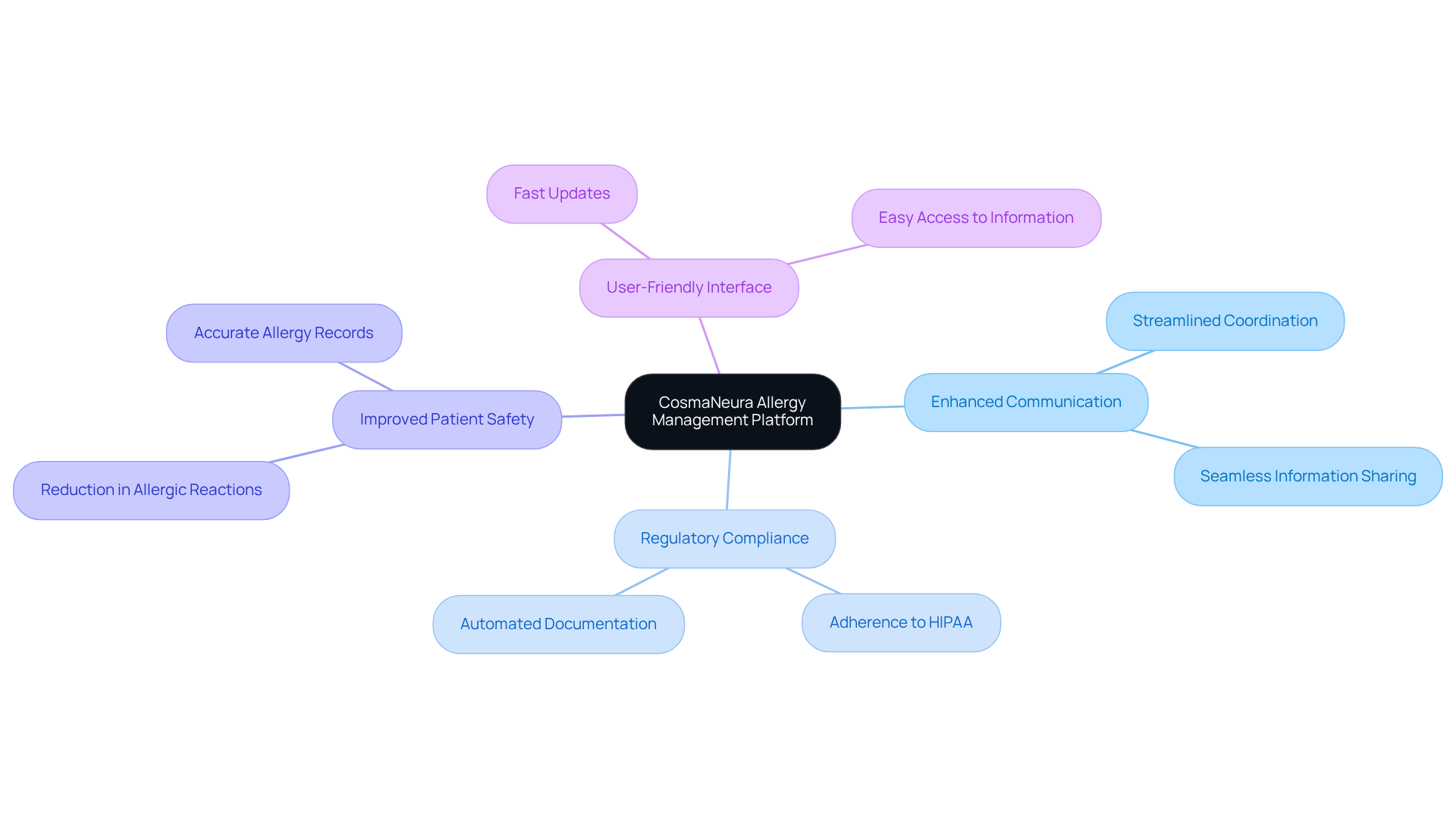
FoodDocs Allergen Matrix Template: Essential Tool for Food Allergy Management
The FoodDocs allergy chart template serves as a vital resource for culinary service providers, enabling them to effectively monitor and manage allergens in their offerings. Have you considered how crucial it is for all staff to be aware of potential allergens that could trigger reactions? This allergy chart template significantly reduces the risk of cross-contamination and allergic responses, ultimately enhancing hygiene protocols while demonstrating a strong commitment to customer health and well-being.
With approximately 32 million individuals in the U.S. affected by dietary sensitivities, and these challenges costing the economy around $24.8 billion annually, the importance of managing such risks is profound. Specialist insights reveal that real-time tracking of allergens is essential for adhering to culinary regulations, fostering a safer dining experience for everyone.
A case study illustrates that the successful implementation of allergen management frameworks is critical for achieving safety compliance. This reinforces the need for proactive allergen management within the catering industry. To effectively track allergens, it's essential for healthcare providers to regularly review and update their allergy chart template. Are your staff trained on the latest protocols and aware of any changes in menu items? Regular training ensures that everyone is equipped to prioritize safety and well-being.
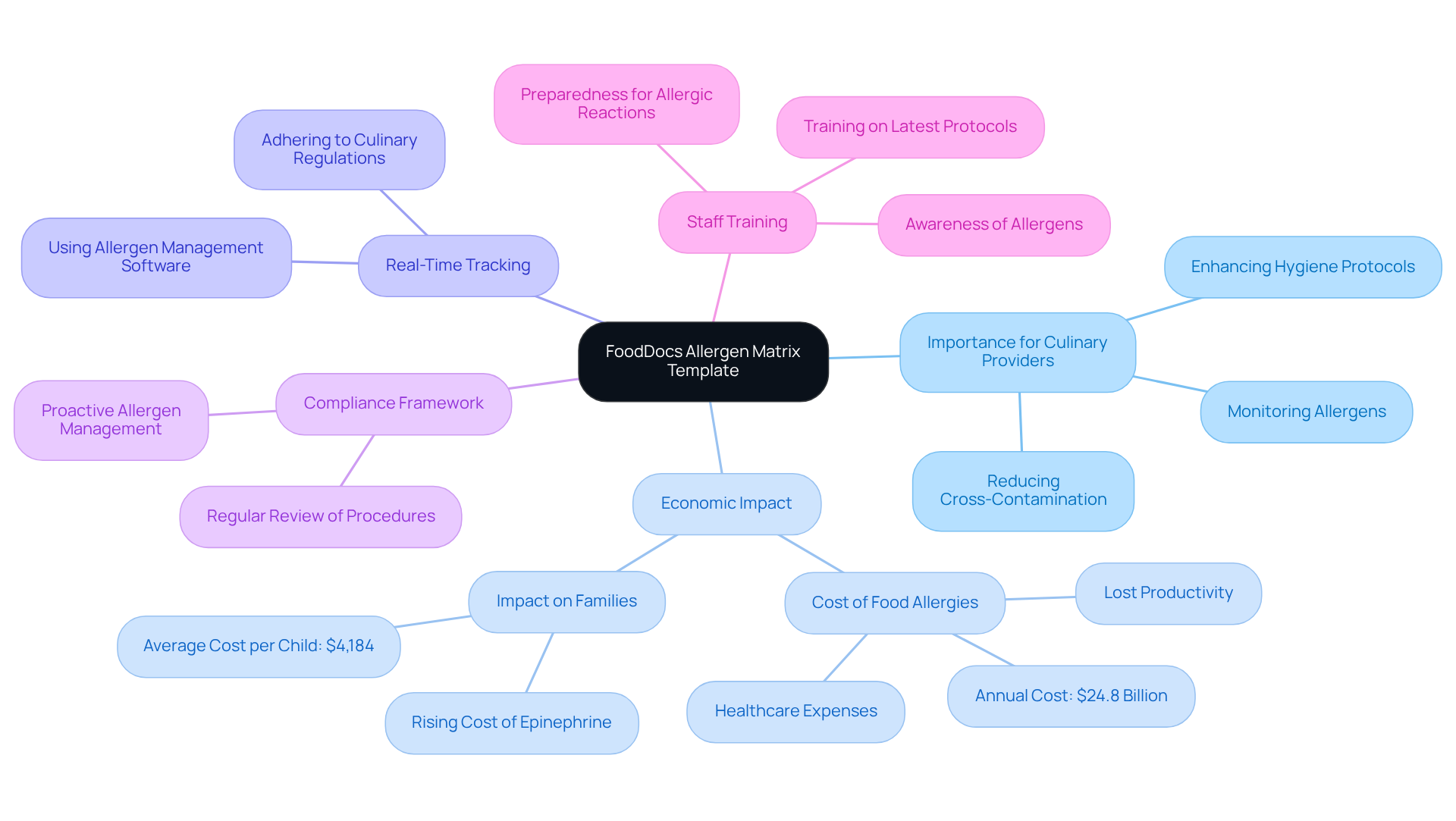
TouchBistro Food Allergen Matrix: Prevent Cross-Contamination in Your Restaurant
The TouchBistro Allergen Matrix serves as a vital resource for restaurants striving to address dietary sensitivities with care. This comprehensive tool clearly outlines the substances found in menu items, empowering staff to make informed decisions that significantly reduce the risk of cross-contamination. By adopting this matrix, dining establishments can create a safer atmosphere for customers with food allergies. This not only nurtures customer trust but also enhances the restaurant's reputation.
Implementing such frameworks has proven to improve compliance with regulations. Experts have noted that organized management practices are essential for minimizing risks associated with hidden ingredients and cross-contact. Recent instances of cross-contamination highlight the pressing need for these tools, as they establish a clear framework for staff training and operational protocols.
Insights from restaurant management specialists emphasize that effective food safety management transcends mere regulatory compliance; it is a crucial component of ensuring customer safety and satisfaction. How can your restaurant benefit from such a proactive approach? By prioritizing food safety, you not only protect your patrons but also foster a welcoming environment that encourages repeat visits.
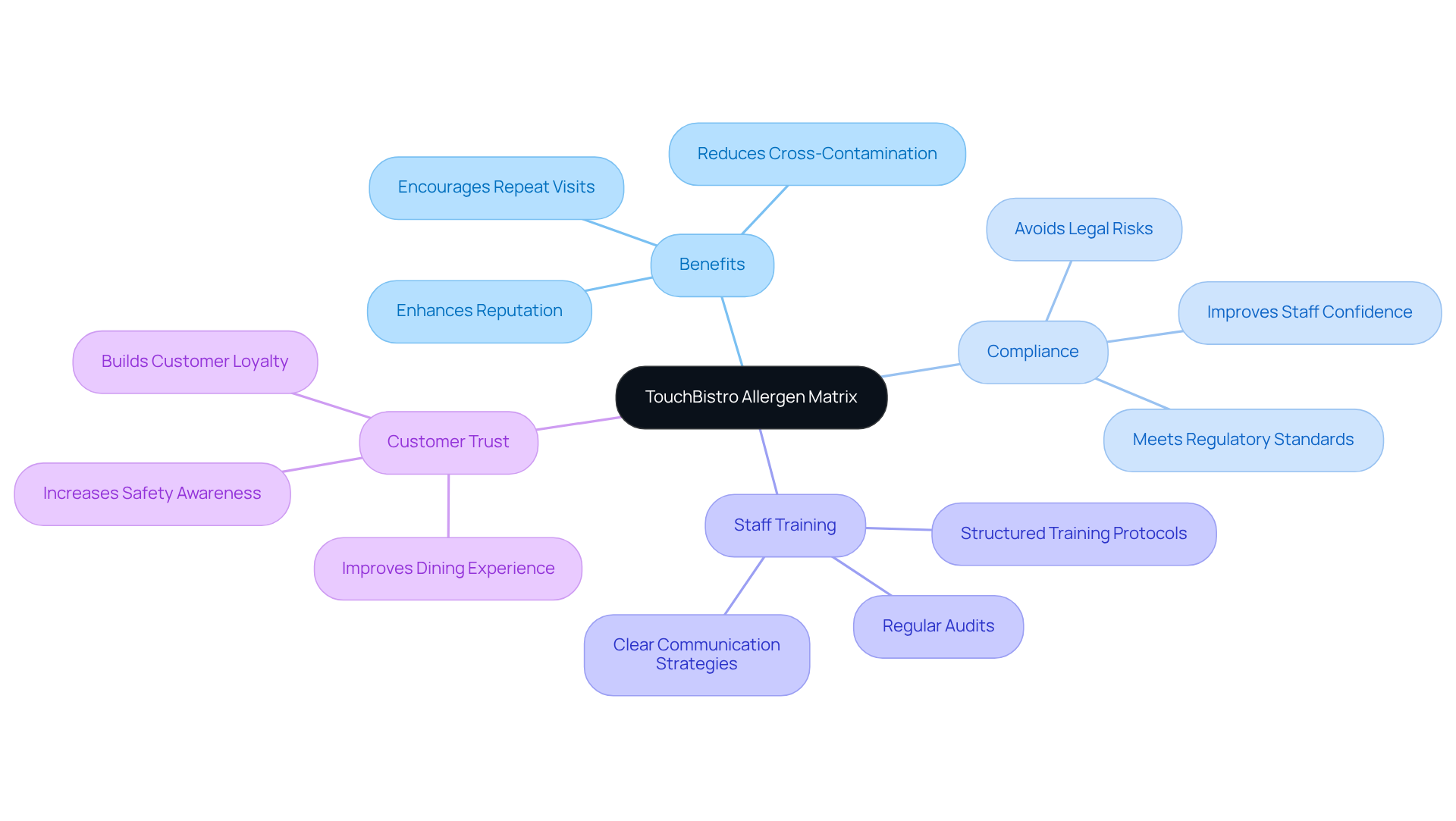
High Speed Training Food Allergy Chart Template: Ensure Compliance in Hospitality
The High Speed Training allergy chart template is an invaluable resource for hospitality providers who genuinely care about their guests' safety and well-being. This comprehensive template not only details critical information on common allergens but also outlines best practices to prevent allergic reactions, addressing the real concerns that staff may have. By incorporating this chart into training programs, hospitality businesses can ensure they meet health regulations while significantly enhancing guest safety.
Imagine a more informed staff, equipped with the knowledge to reduce the risk of allergic incidents. This proactive approach fosters a culture of safety within the establishment, creating a welcoming environment for all. Research indicates that nearly half of fatal reactions related to dietary intolerances over a 13-year span were triggered by items from restaurants or catering services. This statistic highlights the urgent need for adequate training and understanding of food allergies.
Specialized insights, like those from Taylor J. Radke, emphasize that well-trained personnel are better equipped to handle dietary sensitivities. This expertise is crucial in preventing severe reactions and ensuring a pleasant dining experience for every guest. By investing in training using the allergy chart template, hospitality providers can not only protect their guests but also cultivate a nurturing atmosphere that prioritizes safety and care.

Etsy Customized Food Allergy Cards: Personalize Allergy Information for Guests
Etsy offers a diverse selection of customizable food sensitivity cards, allowing guests to express their specific food sensitivities to service providers effectively. These personalized cards can be tailored to include individual preferences and dietary needs, ensuring that staff are well-informed and prepared to cater to each guest's requirements. By introducing these cards, restaurants not only enhance the dining experience for patrons with sensitivities but also demonstrate their commitment to customer well-being and satisfaction.
Consider this: establishments that embrace such personalized approaches can significantly boost loyalty among food-allergic consumers. Recent studies reveal that:
- 92% of these individuals are likely to return frequently after a positive dining experience.
- 76% of food-allergic respondents expect ingredient lists for all menu items, underscoring the critical role of transparency in dining.
The implementation of personalized sensitivity cards also plays a vital role in minimizing risks associated with cross-contact. Alarmingly, 65% of servers may not know how to assist a customer experiencing an adverse reaction. This highlights the urgent need for effective communication tools that foster a safer and more inclusive environment for all diners. As a customer service specialist wisely stated, "Transparent communication regarding harmful substances is crucial for guaranteeing the safety and satisfaction of all visitors." By prioritizing these practices, restaurants can truly make a difference in the lives of their guests.
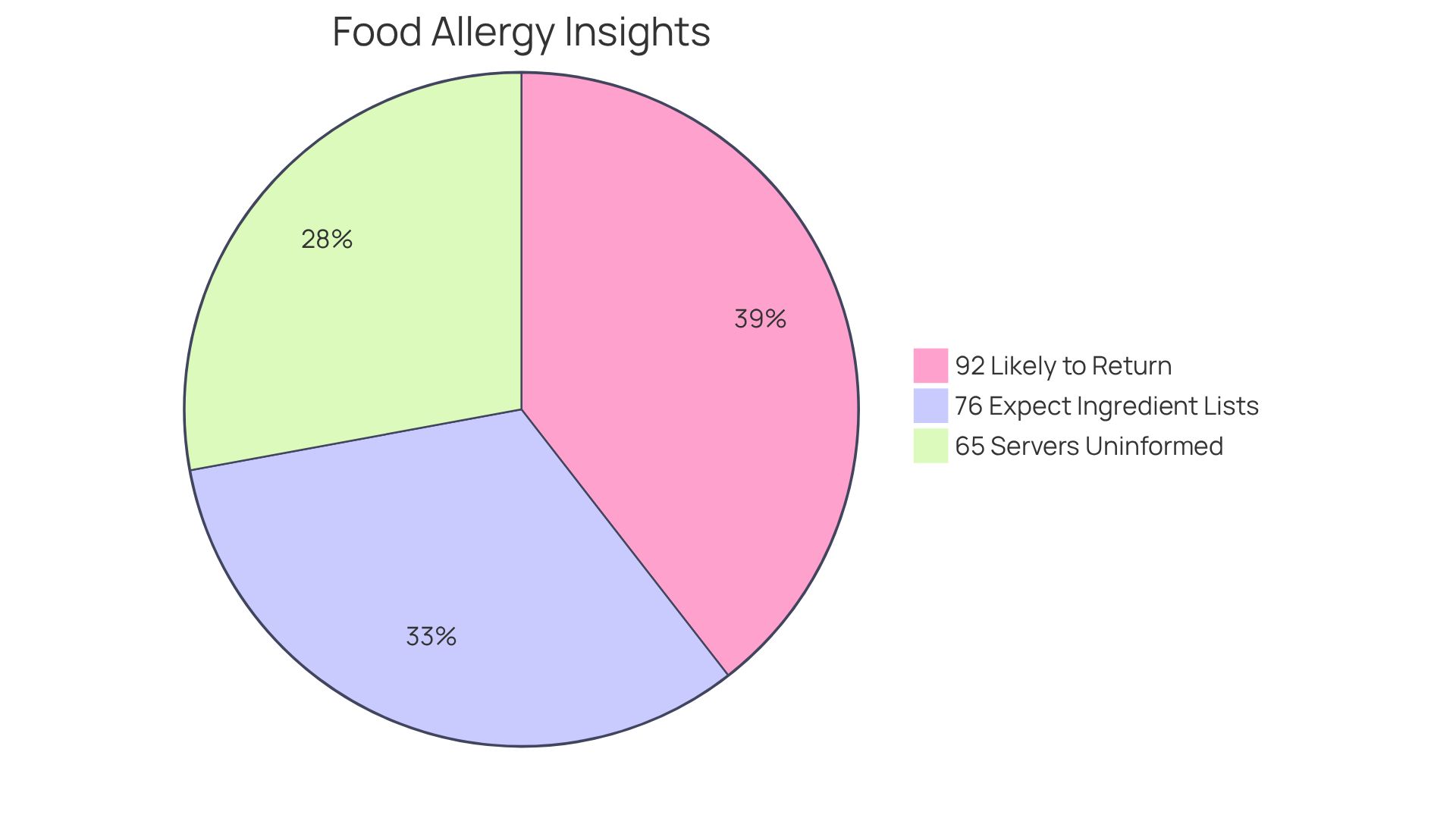
AllergyMenu.app Allergy Matrix: Improve Allergen Management Practices
AllergyMenu.app introduces a groundbreaking allergy framework designed to ease the burden of ingredient control for meal service providers. Have you ever felt overwhelmed by the complexities of managing dietary sensitivities? This app allows users to effortlessly enter menu items alongside their related sensitivities, generating a comprehensive summary that is readily available for staff.
By embracing this innovative technology, service establishments can significantly improve their allergy management practices, fostering a safer dining experience for all patrons. With nearly 33 million people in the United States affected by dietary sensitivities, it is essential to adopt creative solutions that prioritize client protection and satisfaction.
The global dietary intolerance market is projected to reach USD 5.94 billion by 2032, underscoring the growing demand for effective allergen control. By implementing this technology, food providers not only meet safety regulations but also cultivate trust among patrons, allowing them to confidently navigate their dietary restrictions.
Imagine a dining experience where everyone feels safe and cared for. AllergyMenu.app is here to support that vision.

Twinkl Editable Allergy Chart Templates: Enhance Allergy Awareness in Schools
Twinkl offers customizable allergy chart templates that aim to enhance awareness of sensitivities in educational settings. These editable allergy chart templates empower schools to incorporate specific allergens relevant to their community, fostering a safe and inclusive atmosphere. By utilizing these charts, educational institutions can effectively inform students about dietary sensitivities, encouraging responsible behavior during meal times and minimizing the risk of allergic reactions.
Consider this: approximately 6 million children experience reactions to certain foods, and 15% of school-aged kids with such sensitivities have had a response at school, as stated by the CDC. The implementation of these resources not only equips students with vital knowledge but also nurtures a sense of security, ensuring that all staff members are prepared to handle allergy-related incidents. This proactive approach is essential for creating a supportive environment for students with dietary restrictions, ultimately enhancing their safety and well-being.
As highlighted by the CDC:
- "Professional training on food sensitivities for staff members is essential to guarantee effective management and response to allergic reactions."
- By prioritizing education and awareness, we can create an environment where every child feels safe and understood.

Pinterest Allergy Chart Templates: Inspiration for Custom Solutions
Pinterest serves as a vital resource for allergy chart templates, providing a wealth of inspiration tailored to the unique needs of various organizations. Have you ever felt overwhelmed by the challenges of managing dietary allergies in your setting? Users can explore a diverse range of designs and formats that can be easily adapted for use in restaurants, schools, and healthcare environments. By leveraging these innovative solutions, providers can significantly enhance their management practices concerning allergens with the use of an allergy chart template, fostering improved communication with patients and clients alike.
With approximately 33 million Americans affected by dietary allergies, effective allergen management is not just important; it's essential. Did you know that nearly 50% of allergy-related fatalities occur in dining venues? This statistic underscores the critical need for clear communication and precautionary measures. By utilizing Pinterest, healthcare providers can streamline their processes and ensure that safety measures are communicated effectively across various settings.
Integrating insights from allergen management experts can further enhance the reliability of the allergy chart template, making it invaluable in addressing dietary sensitivities. Consider taking action today—explore Pinterest to discover how using an allergy chart template can transform your approach to allergen management and improve the safety and well-being of those you serve.
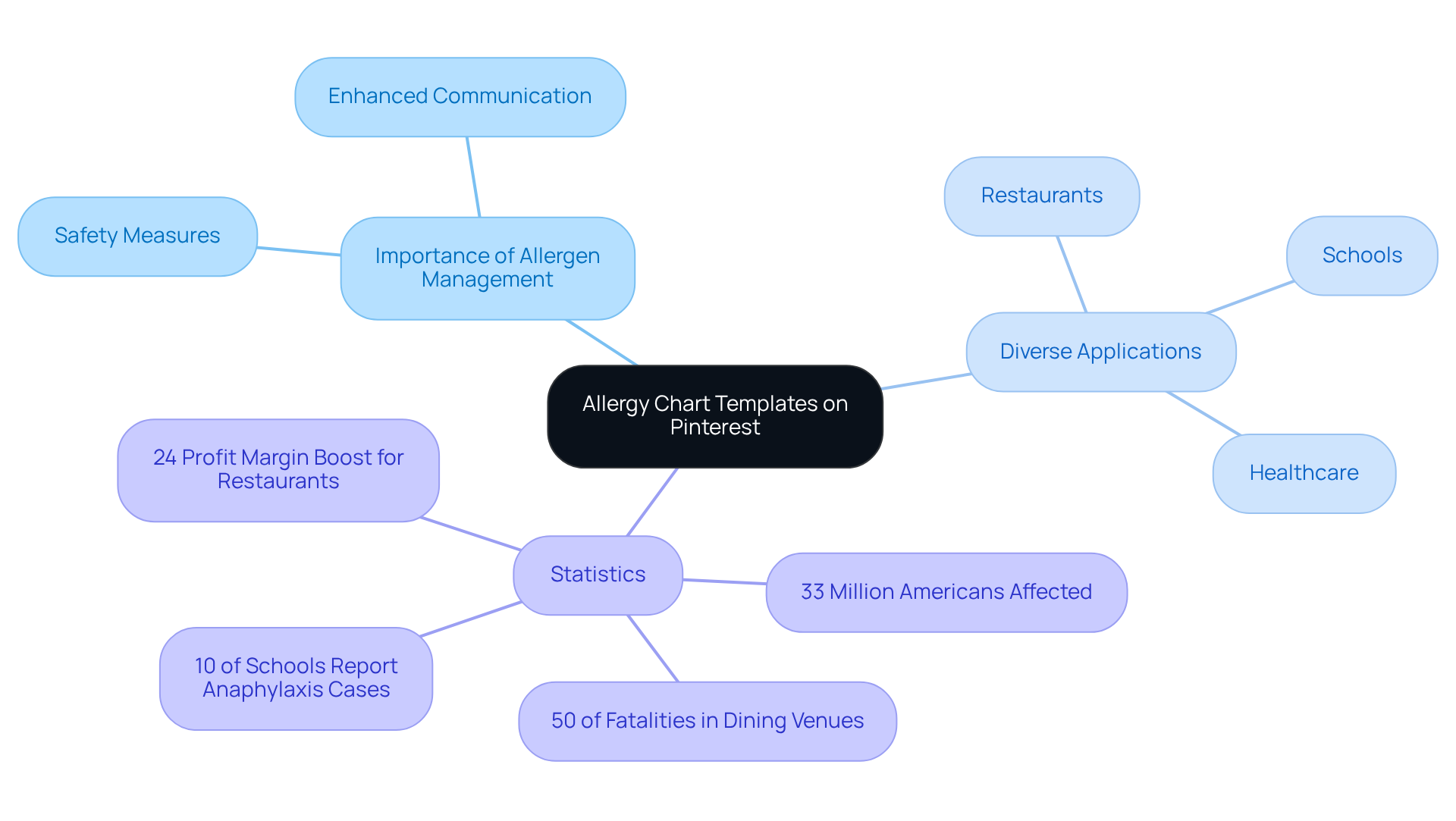
FARE Resources: Essential Education Tools for Food Allergy Awareness
FARE (Food Allergy Research & Education) recognizes the emotional challenges faced by healthcare providers in managing dietary sensitivities. Their extensive range of educational materials—including guides, infographics, and specialized training programs—aims to increase awareness and provide essential support. Among these, the Dietary Sensitivity Patient Toolkit stands out as a valuable resource, helping healthcare providers navigate the complexities of dietary sensitivities with confidence.
Understanding these sensitivities is crucial for enhancing management practices. Research indicates that educational initiatives can significantly improve awareness and readiness within communities, fostering safer environments in schools and public spaces for individuals affected by dietary sensitivities. This is especially important given the alarming rise in dietary sensitivities, which have increased by 50% among children from 1997 to 2011, and again by 50% from 2007 to 2021. How can we ensure that everyone is equipped with the knowledge they need?
As Nicole Canon from Baylor College of Medicine points out, "A 1-hour educational session improved knowledge and attitudes in personnel in the intervention schools." This highlights the profound impact that education can have on community safety. Furthermore, the economic burden of dietary allergies—costing U.S. families nearly $25 billion annually—underscores the urgent need for effective allergy management and educational initiatives.
Together, we can create a supportive environment by prioritizing education and awareness. Let’s encourage further engagement with these resources to empower healthcare providers and enhance the well-being of those affected by dietary sensitivities.
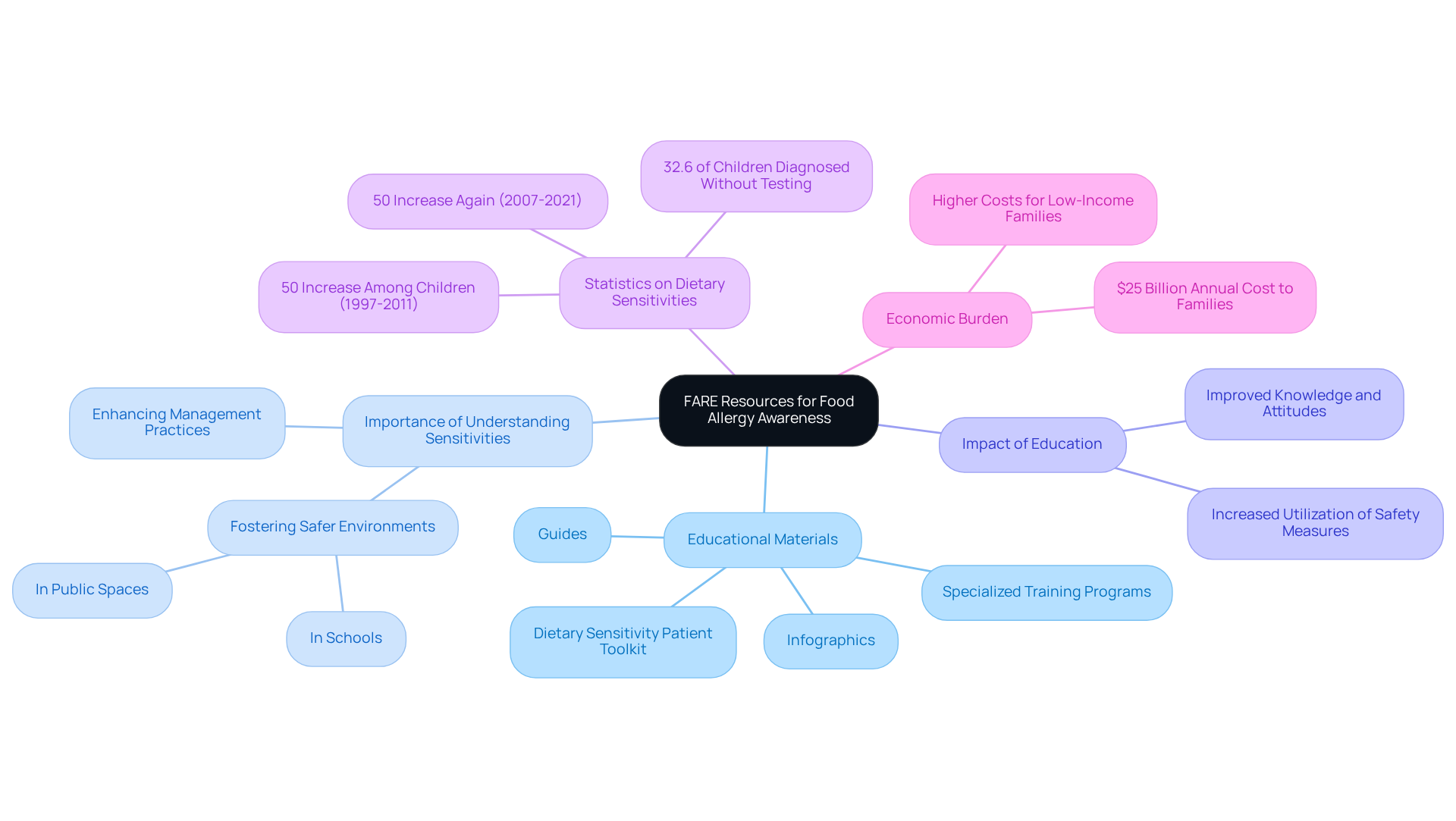
Food Allergy Chart from foodallergy.org: Track Allergens for Safe Dining
Navigating food allergies can be a daunting experience for many. The allergy chart template from foodallergy.org serves as a reliable tool to help monitor triggers in various edible items. This chart provides comprehensive details about common allergens and their origins, empowering service providers to make informed choices when preparing meals.
By utilizing the allergy chart template, restaurants and other food providers can create a safer dining experience for customers with food allergies. This not only reinforces their commitment to health and safety but also fosters trust and reassurance among patrons. Imagine the peace of mind that comes with knowing that your dietary needs are understood and respected.
Incorporating this resource into daily operations can significantly enhance the dining experience for those with food allergies by utilizing an allergy chart template. It is a simple yet impactful step that demonstrates care and consideration for the well-being of every customer. Together, we can ensure that dining out is a safe and enjoyable experience for everyone.
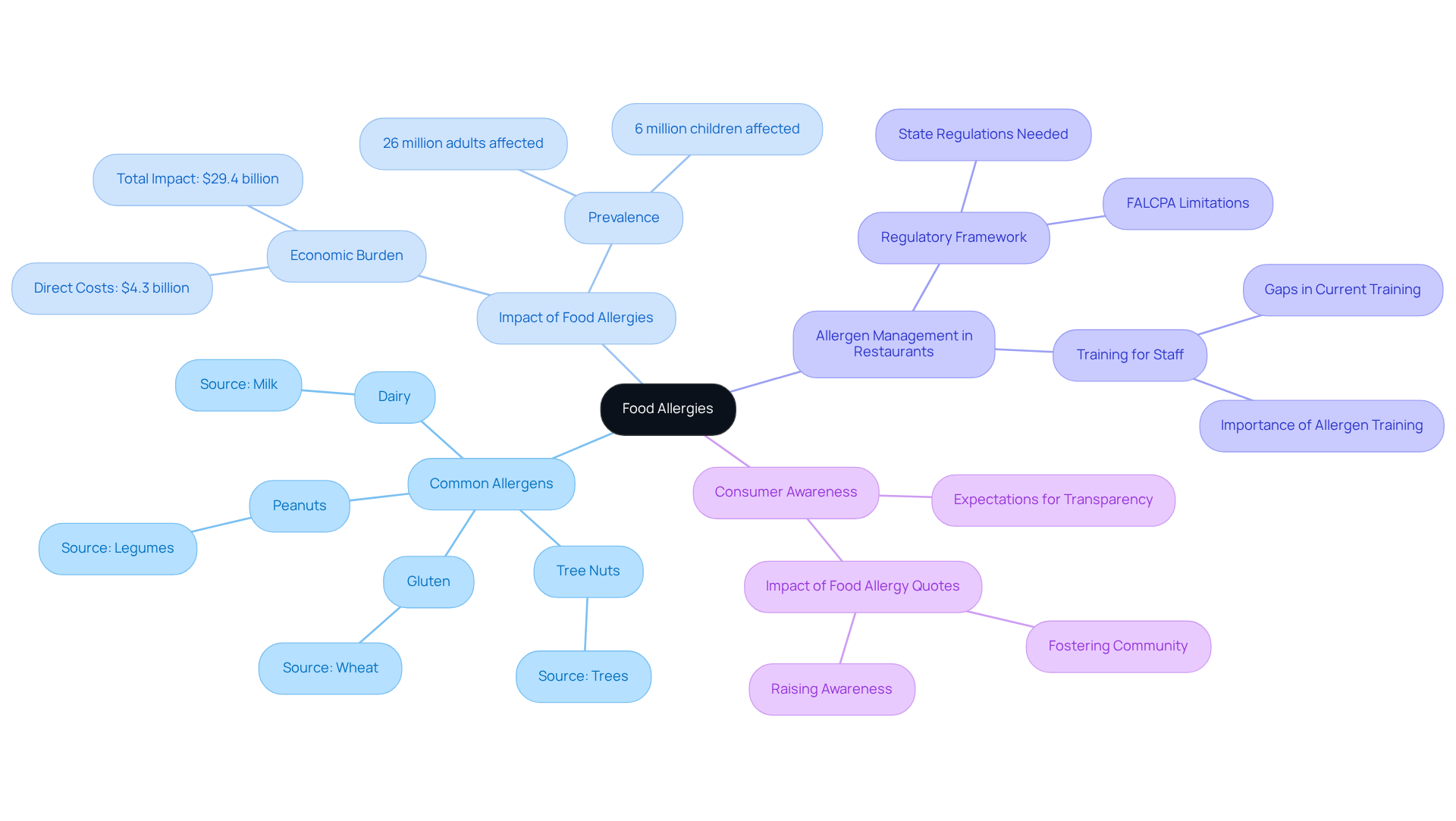
Conclusion
The significance of effective allergy management cannot be overstated, particularly in healthcare and dining environments where patient and customer safety is paramount. Have you considered the emotional challenges faced by those with dietary sensitivities? This article highlights a variety of essential allergy chart templates that serve as crucial tools for healthcare providers, culinary services, and educational institutions. By implementing these templates, organizations can enhance communication, ensure compliance with regulations, and ultimately protect the well-being of individuals.
Key insights from the discussion reveal the diverse applications of allergy chart templates:
- From the CosmaNeura platform's automated documentation
- To the personalized food allergy cards available on Etsy
Each template offers unique benefits. Imagine improved patient safety, streamlined training for staff, and enhanced awareness in schools. The emphasis on education and proactive management is vital, as it empowers providers to create environments that prioritize safety and care for all.
In conclusion, embracing these allergy management tools is not just a best practice; it is a necessary step toward fostering a culture of safety and inclusivity. By prioritizing effective documentation and communication regarding allergens, healthcare providers and food service establishments can significantly reduce the risk of allergic reactions. It is imperative for all stakeholders to engage with these resources actively. How can we ensure that every individual feels safe and understood in their dining and healthcare experiences?




